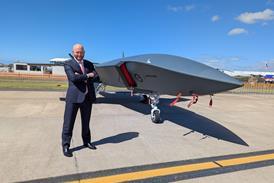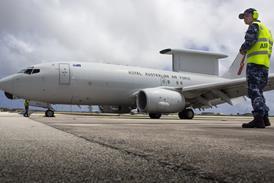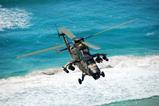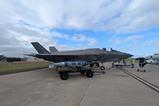Indonesian Aerospace is focused on boosting sales of its N219 twin-turboprop, as it seeks to grow its capabilities through military offset work.
Gita Amperiawan, president director of Indonesian Aerospace since 2022, comes across as a powerful advocate of his nation’s aerospace ambitions as he looks to boost sales for the company’s flagship N219, generate sales for licence-produced aircraft, optimise offset work, and support Indonesia’s nascent electric vertical take-off and landing (eVTOL) aircraft sector.
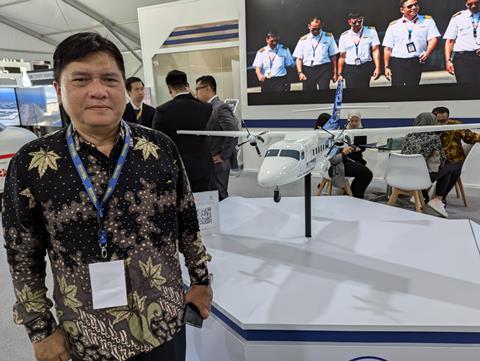
Speaking to FlightGlobal on 18 September at the Bali air show, Amperiawan offered several reasons in support of Indonesia’s sovereign aerospace capability. These include self-sufficiency, deterrence, as well as economic growth. Before joining Indonesian Aerospace Amperiawan had high-level roles in the defence ministry and previously served as a two star general in charge of MRO for the Indonesian air force.
“The message from me is that it is strong for defence, and supports national economic growth,” he says.
Indonesian Aerospace is a major employer of skilled aerospace workers, with 3,000 staff mostly in the Javanese city of Bandung, where it produces aircraft and performs modification work in support of a range of programmes. In addition to its Bandung production centre it has a sales office in Jakarta.
The company’s N219 has the distinction of being Southeast Asia’s sole domestically-designed and -developed major aircraft programme. The type recently made its show debut at the inaugural Bali air show.
Powered by a pair of Pratt & Whitney Canada PT6 engines, the 19-seater is pitched as a rugged transport optimised for the rough and varied conditions found throughout Indonesia and the developing world.
Work is underway with US company Momentum Aeronautics to develop and certify an amphibious version of the aircraft. Indonesian Aerospace also plans to pressurise the N219’s cockpit, allowing cargo operations at high altitudes.
Since its launch in the late 2000s the aircraft’s journey has been tough. Originally intended for Indonesia’s commercial air travel market, it gained early commitments for dozens of examples from local carriers, but these ultimately came to naught. It was only in late 2023, six years after its first flight in 2017 and three years after certification in 2020, that the N219 secured a six-aircraft order from the Indonesian army.
After the army contract becomes effective late this year, it will take 24 months to deliver the first aircraft. The army’s first aircraft will not be in the baseline standard, but in the new amphibious configuration. Funding has already been cleared for the amphibious version. Production of the variant will start in 2025, followed with a first flight in 2026 and certification in 2027.
Asked about the dissipation of the N219’s early commercial promise, Amperiawan suggests that Indonesian Aerospace – also known as PTDI – underestimated the vagaries of the commercial market.
“What PTDI did for a long, long time was work with the military,” says Amperiawan. “Once we got certification for the N219 there was no problem selling to the military.”
Airlines, the airframer discovered, were heavily influenced by the views of lessors, who are in turn concerned about an aircraft’s secondary market. Where the military has an integral MRO function, airlines wondered about the availability of MRO support.
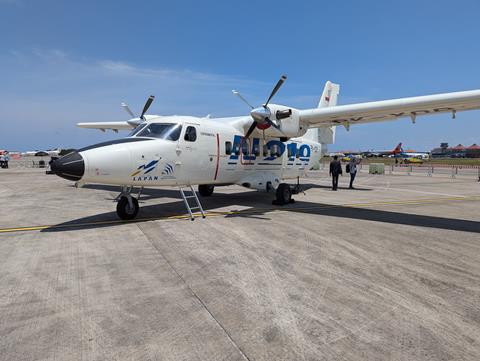
Despite the slow start, things appear to be turning for the N219 and the aircraft has enjoyed its first international success. In early September, Democratic Republic of the Congo company Setdco Group signed a contract for five N219s in a deal worth $66.2 million.
In 2023, Indonesian Aerospace secured an agreement with China’s Linkfield Technologies that could see 25 units sold in the Chinese market. The deal could also see local production in China’s western Xinjiang province.
Amperiawan is also upbeat about selling the type to operators that serve Indonesia’s massive resources sector.
Indonesian Aerospace continues to promote the NC212 and CN235, both of which it produces under license from Airbus. Cirium fleets data indicates that there are 47 Indonesian-built CN235s in service. Operators include Indonesia’s armed forces as well operators in South Korea, Malaysia, Pakistan, Mauritania, Thailand, Senegal, and others. The Democratic Republic of the Congo also committed to a pair of CN235s when the Setdco N219 contract was signed.
Globally there are 59 Indonesian-built NC212s in service. Indonesia is a major operator of the type, but Indonesian Aerospace has also sold the aircraft to Thailand, Vietnam, and the Philippines.
While Amperiawan is bullish on the prospects for both types, he warns about challenges with the supply chain.
“We have to be very careful about our global suppliers,” he says. “First about the price, second about the lead time. Supply chain is our serious concern right now just to make the business go as planned.”
Another significant ambition is a possible airborne early warning and control (AEW&C) aircraft, a capability the Indonesian air force lacks. The need for situational awareness is already pressing given rising geopolitical tensions as well as the broader modernisation of the Indonesian air force, underlined by Jakarta’s order for 42 Dassault Aviation Rafale fighters.
Though it has no formal AEW&C requirement, Jakarta has flirted with the acquisition of this key airpower enabler for years. To address any potential future need Indonesian Aerospace is exploring the possibility of working with Turkey’s Havelsan. The Turkish company was instrumental in the development of Ankara’s Boeing E-7 Peace Eagle programme.
“We would like to have global collaboration so that we can provide the [AEW&C] that our armed forces need,” says Amperiawan.
“To learn, we have to collaborate with the countries that have produced an [AEW&C] aircraft.”
If a prospective Indonesian Aerospace/Havelsan grouping were to win a contract for an AEW&C aircraft, Amperiawan envisages his company serving as the prime contractor. Asked about the aircraft type Indonesian Aerospace would use for any AEW&C offering, Amperiawan indicates that this will depend on government requirements.
Teaming up with Havelsan is by no means unique: Indonesian Aerospace has partnerships with major aerospace firms such as Airbus, Bell, Boeing, and others. There are several big Indonesian defence deals on the horizon that, if realised, could give Indonesian Aerospace significant workshare.
One is a partnership with Lockheed Martin’s Sikorsky unit to pursue the sale of 24 PZL-Mielec produced S-70M Black Hawk helicopters to Jakarta. Amperiawan states that the defence ministry wants the helicopters for the nation’s army, and that final approval now sits with the country’s finance ministry. He hopes for a decision this year, given that delaying approval could see the cost of the acquisition increase.

Indonesian Aerospace has already determined the local work it will undertake and the local content required should the Black Hawk programme move forward. Indonesia has long experience adding equipment to ‘green’ helicopters given its significant activity on imported Bell 412s over the years.
An even more tantalising contract could involve offsets related to a potential Indonesian acquisition of up to 24 Boeing F-15IDs – the local designation for the F-15EX. In 2023, defence minister Subianto Prabowo – who is also the country’s president elect – signed a memoranudm of understanding (MoU) with Boeing for the fighters. This followed an August 2022 MoU between Boeing and Indonesian Aerospace to look at areas to work together for a possible F-15ID sale, and a February 2022 US Foreign Military Sales case for the fighters.
“We met the F-15 teams in Bandung two days ago, talking about the offset programme,” says Amperiawan.
“The responsibility of Indonesian Aerospace is making an offset programme that gives the maximum benefit for industry. We are finishing our arrangements and submitting our proposal for the offsets.”
Amperiawan notes that F-15ID offsets could be both direct ones specifically related to the fighter itself, or indirect offsets related to other programmes. A key consideration is obtaining offsets that can help improve specific aerospace capabilities.
The company also has offsets related to the Rafale acquisition, namely a production work package, an engineering work package, and MRO work. Safran is also providing offsets related to the fighter’s M88 engines. Jakarta is expected receive its first Rafale in 2026.
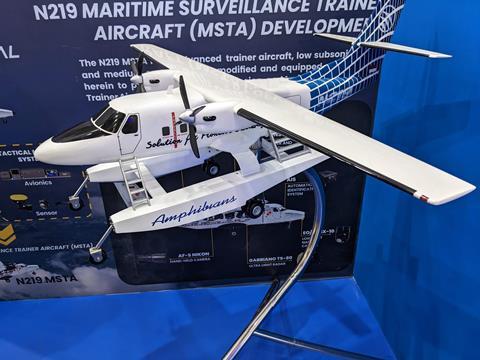
Given its history across a range of aircraft programmes, Indonesian Aerospace is the country’s biggest repository of aerospace know how, especially in areas such as manufacturing and certification. Amperiawan sees this capability as a resource to aid a new crop of Indonesian start-ups focusing on future eVTOL aircraft. Indonesia, with congested cities such as Jakarta and far-flung islands without airports, offers a range of potential applications for eVTOLs.
At the Bali air show, the company’s stand featured a large model of Vela’s developmental Alpha eVTOL. The start-up views the state airframer’s experience with producing and certificating aircraft as essential for the programme. In June, Indonesian Aerospace signed an MoU with another local eVTOL start-up, Intercrus Aero Indonesia, for potential collaboration on its planned Sola eVTOL aircraft.
“PTDI is state-owned, we have to develop the ecosystem,” says Amperiawan. “There are so many bright, young engineers in Vela and Intercrus. We need to accommodate these bright young people and grow the industry.”
Amperiawan feels that Indonesian Aerospace, with its design organisation approval, is particularly well suited to assist such start-ups in the key areas of production and certification.





